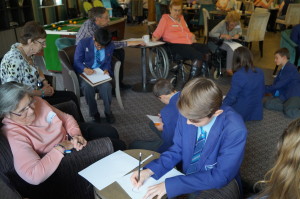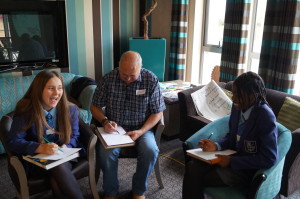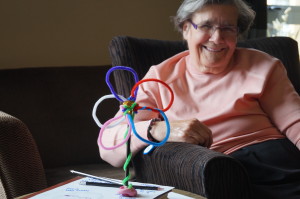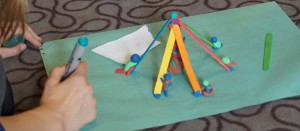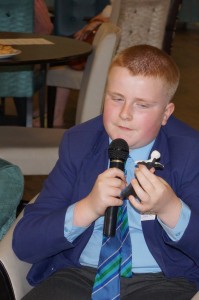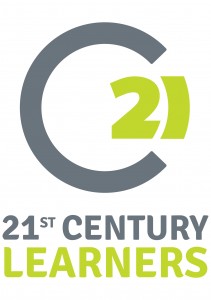Community Values: The Final Dialogue
Our inter-generational dialogue project ended recently with a meeting between Year 8 students from St Thomas More Catholic High School and Residents at Pickmere Court, a supported housing project in Crewe. The project, funded by Crewe Town Council and run by myself and colleagues at TYA Creative, was intended to address the British Values agenda in a meaningful and educationally purposeful way, with a particular emphasis on building understanding between younger and older generations through dialogue. The first post in this series explored the thinking behind the project, whilst the second and third posts explored our work with the older and younger generations separately. Here we describe what happened when the two groups were finally brought together.
In our earlier sessions, both groups had identified diversity and tolerance as key issues for their communities. The older group had talked about the increase in diversity in their lifetimes, and tentatively linked this to a perceived fall in tolerance. The younger group were adamant that diversity was a strength of the community – that a multiplicity of views provides us with more ‘starting points’, more perspectives, which, when properly combined, should lead to better decision making and stronger local policies. They connected this to the need for ‘equality‘ and ‘inclusion‘ – for all groups to have a voice in their communities. Both older and younger generations were concerned to have a strong and truly representative local democracy.
The final session had the following over-arching question: “What can we do to to ensure that everybody has a voice in our community?” This was intended to be a practical question, with the ‘we’ referring to the participants. Before looking for practical answers, we began by testing the assumption within the question that representation for all groups within the community is a desirable aim. The ‘ground rules‘ of effective dialogue used throughout the project were again shared. After a few ‘getting to know you’ games, each of the Pickmere residents was paired with a student, and the pairs were asked to draw each other (this was an extension of the ice-breaker activities, with the emphasis on fun). Participants were then to interview their partner, to identify any concrete examples from their experience in which they or people they knew had needed a voice in the local community. Notes were made in the ‘frames’ of the portraits. Pairs then came together in fours, with each person introducing their partner, showing their portrait and relating their example of the importance of having a ‘voice’.
An image was then shown of Crewe’s War Memorial, built to remind us of something that should not be forgotten. Each group was asked to create something to contribute to an ‘installation’ reminding us of the importance of including everybody in local democracy. A variety of materials for creating physical sculptures was available; groups were also given the option to draw, write poetry or create a ‘tableau’ with their bodies. The intention here was to require the groups to explore each other’s thinking and combine it to the point where they could express themselves with a simple image or verse; it was a device to create the need for effective communication through dialogue. To further this, the groups were asked to produce a short name plate for their piece. Examples of the work produced are shown below:
In ‘We Count‘ the central post, composed of intertwined threads, represents the community. It is both composed of and supported by different community groups (or individuals?) represented by the sticks held up by figures. If even one of the supporting groups is excluded or withdraws its support, the community topples. ‘Charlie‘ is a figure representing the community. Should s/he lose any of his / her fingers or toes or other component body parts (representing community groups or individuals) then s/he would cease to ‘function in a meaningful way’. For the ‘body’ of the community to be healthy and function, it is dependent on all its constituent parts. ‘Together in Love‘ is a memorial to war or community conflict. The petals of the flower represent the values of tolerance, equality, inclusion etc. Should these values be lost, the flower will die and conflict will result.
Each piece was shared and probing questions were asked, before the group came together to return to the question of what they could do to ensure that everybody in their community has a voice. Older participants recalled times when every area in the town had a community meeting place; the need for such spaces in individual housing areas that somehow ‘feed in’ to a town-wide structure was stressed. The students invited the Pickmere residents to make a return visit to St Thomas More to continue the dialogue. A suggestion was made that the school could host a model community hub with students trained to facilitate critical dialogue, with the opportunity to replicate this elsewhere. One small practical step that is being taken is for some of the participants in this project to report back to Crewe Town Council and assert their belief that more could be done to include all groups in decision making processes in their communities, and that without this level of inclusion community cannot exist in a meaningful way.
Huge thank yous are owed to those who participated in and supported the project, including Crewe Town Council, the residents and staff at Pickmere Court, the teachers and students at St Thomas More Catholic High School and members of the Royal British Legion in Crewe. Although somewhat restricted and small in scope, I hope this project demonstrates the potential for teaching ‘British Values’ – the importance of self-knowledge, respect for others and contributing to our communities – in a way that is educationally purposeful and enriching. The ability to engage in genuine, exploratory dialogue – to reason across difference – is, I believe, essential for the health of all our communities, local and global.


